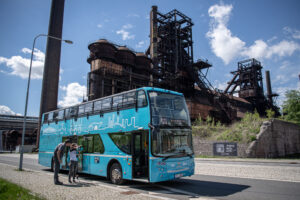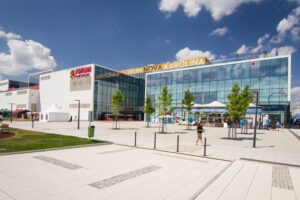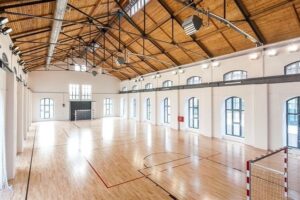
A brownfield is a building, complex or site that is no longer used for its former purpose, is derelict or neglected, and may also be contaminated. Brownfields may be the result of industrial, agricultural or military activity, or they may be former residential sites. In order for a brownfield to be used appropriately and effectively, it must first undergo a process of regeneration.
Ostrava offers investors a number of opportunities at brownfield sites in the city. It is estimated that around 8.9% of Ostrava’s total area (19.04 km2)is affected by former industrial activity. The largest brownfield sites in the city (which have undergone or are undergoing large-scale renovation projects) are at Karolina, Lower Vítkovice, and Hrušov. All these sites are owned by private investors, who have breathed new life into them and continue to develop them.
Most of these sites are in private ownership. A complete database can be found at this website.
Examples of good practice:
Lower Vítkovice
NATIONAL CULTURAL MONUMENT
Covering an area of around 150 ha, this is a former industrial complex that was active from 1828 until 1998 and was a major centre of metallurgical production and related industries. It is divided into three parts. In the north is the former Hlubina coal mine, the blast furnaces, coking plant and chemical works. The central part was used for mechanical engineering. The southernmost part was the site of several industrial and administrative buildings.
In the autumn of 2003, the complex was taken over by the Vítkovice company (Vítkovice, a. s.). The majority of the site has now been revitalized, and it has the status of a National Cultural Monument.
As part of this revitalization project, a century-old former gas-holder was converted into an auditorium and congress centre for 1 500 people, now known as the Gong. The nearby power plant (the U6 building), dating from 1911, became an education centre focusing on technical studies for primary schools. The Science and Technology Centre, opened on 26 September 2014, has signed a memorandum of cooperation and understanding with one of the world’s most prestigious museums of its type (the American Museum of Natural History in New York), opening up exciting possibilities for intercontinental cooperation. Other sites revitalized as part of this project include the Landek Park mining museum and the Karolina Triple Hall, a former industrial power plant. The project was headed by the head of the Vítkovice company Jan Světlík, and its architectural concept was coordinated by Josef Pleskot and his AP Studio.
Another part of the Vítkovice complex is currently the focus of the “New Vítkovice” revitalization project.
The total cost of the revitalization work at the Lower Vítkovice complex also includes investments in accompanying infrastructure (coordinated by a consortium of partners operating as “DOV” – Dolní oblast Vítkovice), the energy centre (coordinated by Vítkovice, a. s.), the extension of Ruská Street (coordinated by the City of Ostrava), the conversion and re-opening of the former Hlubina coal mine (coordinated by DOV), and the demolition of some buildings near the Hlubina site (coordinated by the Moravian-Silesian Region), making up around 500–600 million CZK in total.
The total cost of the revitalization so far is around 1 billion CZK.
Project coordinator: Dolní oblast Vítkovice, consortium of legal entities
The Gong
As part of the Vítkovice regeneration project, a century-old former gas-holder was converted into a multifunctional auditorium and congress centre for 1 500 people, now known as the Gong. Designed by the architect Josef Pleskot and his AP Studio, the Gong provides facilities for congresses, concerts, and other educational, cultural and community events. The original structure of the gas-holder has remained almost entirely intact, making the Gong a visually impressive statement.
Total cost: 313 million CZK (excl. VAT)
Subsidy funding: 311 million CZK
Subsidy programme: IOP
Construction/completion: 10/2010-11/2012, opened to the public: 5/2012
Bolt Tower – blast furnace no. 1
A unique superstructure (over 20 metres high) has been installed on the top of a historic blast furnace, with a spiral-shaped walkway for visitors and a viewing platform 80 metres above ground level. The Bolt Tower offers spectacular views of the city and the surrounding area (including the Beskydy Mountains), as well as a café and a club used for teaching technology to student groups. The tour route guides visitors through the entire process of iron production in the blast furnace. The skip hoist that used to lift iron ore and coke to the top of the furnace has now been replaced by an elevator for visitors.
Total cost: 50 million CZK (excl. VAT)
Subsidy funding: 50 million CZK
Subsidy programme: IOP
Construction/completion: 3/2011 – 2/2012, opened to the public: 3/2012
U6 – Small World of Technology
The U6 building (a former power plant) contains around 100 interactive exhibits showcasing all the key advances in science and technology during the past two centuries. Guided by the spirit of Jules Verne, visitors of all ages can enjoy hands-on demonstrations of revolutionary inventions and technologies – from steam engines to steelmaking, from space flights to deep-ocean diving. The Small World of Technology is not a museum in the traditional sense: it is an educational playground that teaches technical knowledge in a fun, entertaining way.
Total cost: 118 million CZK (excl. VAT)
Subsidy funding: 118 million CZK
Subsidy programme: IOP
Construction/completion: 6/2011 – 11/2012, opened to the public: 11/2012
Science and Technology Centre (STC)
The Science and Technology Centre is open both to schools and to the general public. It presents fascinating aspects of science and technology in a playful, entertaining way, so visitors of all ages groups can make their own discoveries and develop a real enthusiasm for the subject. This is very different to a school textbook full of numbers: here you can see for yourself the workings of a city or the human body, you can time-travel back to the prehistoric era when the mammoth-hunters lived, you can understand what a rainbow or a thunderstorm is, and much more.
Total cost: 510-520 million CZK
Subsidy funding:
Subsidy programme: OP Research and Development for Innovation
Construction/completion: 5/2012 – 9/2014, construction: 5/2012 – 9/2014, creation of exhibitions: /2014 – 9/2014, project launched: 11/2012
Hlubina coal mine
The former Hlubina coal mine is a National Cultural Monument where 5 historic buildings were revitalized to create facilities for artists, creative activities and cultural institutions. This is the cultural and artistic counterpart to the science and technology-focused revitalization in the other parts of Lower Vítkovice.
















Karolina
ONCE AN INDUSTRIAL SITE, NOW A BRAND-NEW DISTRICT OF CENTRAL OSTRAVA
Today’s “New Karolina” complex used to be a huge brownfield in the heart of Ostrava. It was the site of a coking plant (active from 1858) and a power plant (built in 1905).
In the second half of the 20th century, industrial production was gradually scaled down at the site and eventually stopped entirely. The coking plant was closed in 1964, and the power plant operated until 1974. All the buildings at the complex were demolished except the two power plant halls.
Both these buildings are now listed as valuable examples of historical industrial architecture, and they have been revitalized to create a huge “covered square” that is used for cultural, sporting and community activities. Together, the two buildings form the “Triple Hall” (Trojhalí) complex (triple because the larger of the halls is actually two halls combined). The entire Karolina site underwent a lengthy cleanup process to remove the contaminants left behind by decades of industrial production. This created a huge vacant site (32 ha) bounded by 28. října Street at the north and Místecká Street (plus the railway line) to the west. The site became the location for an entirely new district of the city centre, known as New Karolina (Nová Karolina).
The New Karolina development included the Forum Nová Karolina shopping centre (96 882 m2), residential buildings, and the Nová Karolina Park office complex (67 720 m2). The development has a large underground parking garage. In 2024 the new Organica office building was opened. The main square of the New Karolina district (Náměstí Biskupa Bruna) is set to be redeveloped. The complex is expanding further with the addition of new residential buildings, and new transportation infrastructure (including cycle routes) is being created.
This project has created a novel type of public space – a kind of multifunctional covered square. It offers permanent sports facilities, and it has become a popular venue for a wide variety of public activities and events, attracting people from the entire region. Even if there is a metre of snow outside, you can still enjoy in-line skating here, organize a flea market, or give a theatre performance or concert.








Hrušov
The Hrušov development zone is located close to the Odra River and the D1 international highway, alongside Bohumínská Street. This was an example of a “social brownfield”: instead of being used for industrial production, it was the site of accommodation blocks for workers at local factories and mines. This accommodation functioned until 1989, but then the area became increasingly depopulated – culminating in the devastating floods of 1997. Currently the Hrušov development zone is used for light industrial production, logistics and offices. See more information at the zone’s website.

























